 The Judge
RAVES!
The Judge
RAVES!
Date: 03/07/09
Reich und Kraft
Last night, I hied me the sixty-odd miles to the Manchester Velodrome for a unique double-bill. For not only were my beloved Kraftwerk playing one of only two UK gigs they're scheduled to do this year, but the 'support act' - if they can be given what is usually a term denoting inferiority or insignificance - was New York's Bang On A Can All-Stars giving a world première performance of 2x5 by the legendary Steve Reich.
So how did I, with my notorious aversion to travel (although it's more an aversion to all the hoop-la and arrangements you have to go through to do it) end up going to this gig? Well, my friends Tez and Wendy have been trying to get me to a gig for over a decade. They'd seen Kraftwerk at the 'Stop Sellafield' gig in Manchester in 1992, then again at Tribal Gathering in '97 and then in Manchester once more around the start of the current decade, and very much wanted me not to miss out.
They finally figured out that the only way they would ever succeed was by buying the tickets first and then telling me. They managed to do this because, for once, they knew about the gig before I did.
That was over three months ago, and so it was a long countdown to late yesterday afternoon, when we set out for Manchester. The weather was horrendously hot and humid. Horrendous for me, that is: once both the temperature and humidity go over 70, that's it as far as I'm concerned.
We arrived at the venue over an hour before the gig was due to start. Or, rather, we arrived one of the car parks at that time. It's a fair step from there to the venue itself, and I nearly passed out by the time we got to the Velodrome.
Manchester Velodrome is built on derelict industrial land on the eastern side of the city, and is the shape you would expect from a cycling arena. It is also - so I discovered the other day - built on the site of a former power station. So why put a gig on there, of all places? Well Alex Poots, Executive Producer of the Manchester International Festival, had been trying to get Kraftwerk to the city for ages, and then finally realised that - given Ralf Hütter's passion for cycling - this was the carrot to dangle before him. He got a positive response within a few days.
Having got inside, we went looking for the merchandising stalls. We found one on the south-west corner, but I have to say that the range they had on offer was quite disappointing. There was another stall down on the floor of the venue, but there was no way we could get down there from where we were, so we were left to get whatever refreshment we could before going to find our seats. These turned out to be at the start of the home straight to the left of the stage. Wendy apologised for the location, and wished she had got us tickets for somewhere with a better angle. They were fine, though, and gave us a good view of the stage.
Walking into the arena, we saw that the stage had been set up in front of the south curve of the track, with most of the remainder of the central area set aside for those who preferred to stand. On the stage stood a grand piano, a drum kit, a couple of electric guitars and a bass guitar, along with five chairs and some music stands.
Steve Reich's new piece, 2x5, was written for either two groups of five musicians - each group doubling the other - or one group of five musicians doubling a recording of themselves. This latter setup was clearly what we were going to be getting. Sure enough, at about 7:50 (somewhat later than the "7:30 pm prompt start" stated on the tickets), the five members of this incarnation of the Bang On A Can All-Stars emerged onto the stage to polite applause from a venue which was little more than two-thirds full at this point, sat at their instruments and then, with no ceremony, launched into the piece.
I lack a sufficiently in-depth knowledge either of Reich's music or of musical terminology to be able to give you any useful description of 2x5. All I can say is that it appeared to comprise four main sections (the first quite fast, the second slower, followed by another fast section and what seemed to be a recapitulation of the first), with the transitions between them managed by vamping from bass and the lower end of the piano, the rhythm being carried as much by these instruments as by the drums. The melody lines are played almost entirely on the high treble strings of the guitar and punctuated by clawed clusters of notes (the guitarist responsible for these played them with almost Townshendian flourish and then, after each, smoothed down his frizzy hair with his picking hand), and reminders of Reich's earlier Electric Counterpoint were never far away.
The piece - although not showing any major progression in Reich's composing style (and why should he bother at 73?) - is nonetheless a pleasing addition to the canon, and was played with great attack and confidence, and it was a shame that a large proportion of the audience then present seemed to prefer talking through most of it.
But where was the composer? We had been told that the ensemble would be "directed by Steve Reich" himself, but he had not appeared. All became clear as the group took its applause. They pointed to the very back of the standing area. There - wearing his distinctive cap - stood the great man, who waved to acknowledge the extra burst of applause which met him.
Some of us then took the opportunity to get out of the heat of the auditorium (if the Velodrome has any air conditioning, it wasn't apparent) back to the outer ring of the building, where at least there were some windows open to allow what little breeze there was to percolate in.
The audience demographic (if I must use such a word) appeared to be 65 per cent male and concentrated around the 35-45 age range. Perhaps many of these people were like me in being what they now call 'early-adopters', but I suspect most of them had come to the band in the early 1990s thanks to The Mix.
We returned some seven or eight minutes later to find the stage closed off on all three sides by a grey curtain, rather like the Kaaba at Mecca, only this was plain grey and some small coloured spotlights were shining on it. There was a brief cheer as we saw the shadows of pairs of spindly legs appear projected onto the bottom of the curtain. Could it be that Our Heroes were really aliens after all, and midget ones to boot?
As ever, there was no formal warning that the set was about to start; just the sets of swooping tones which can be heard on the front page of their website, only lower and slower. After a couple of minutes of this, there then came the familiar robotic announcement:
"Meine Dammen und Herren...Ladies and gentlemen...Heute Abend...Die Mensch Maschine...Kraft...werk!"
The ticking beat of Man-Machine started, causing a roar from the audience (which had increased in size during the interval, although there were still empty seats to be seen). Gradually, the curtains pulled back from the front and back along the sides to reveal the four cybernauts. Each man - wearing a dark grey shiny zip-top - stood behind his laptop in the familiar order: Ralf Hütter, the remaining founder member, on the left; then Henning Schmitz and Fritz Hilpert; with new-boy Stefan Pfaffe taking the place of the now-departed founder member Florian Schneider on the right. These were on a slightly raised dais in the centre of the stage, the dais having a strip of light around its lower edge which changed colour a number of times during the evening.
The first thing which struck me seeing them standing there was that Fritz was a short-arse. I realised after a while that he wasn't much shorter than Henning or Ralf, it was just that Stefan - standing next to him - was a great deal taller than any of them.
The second thing which hit me was a sense of disbelief that - thirty-four years after I got my first Kraftwerk record (the 7" of Autobahn), here I was actually seeing them. OK, times and technology have moved on, but this was the band I had carried a torch for back when they and their music were being dismissed as cold and inhuman and a likely cause of The End Of The Musical World As We Know It; the band I had championed in the face of the amusement and bemusement of my denim- and leather-clad contemporaries; the band which I knew to be significant long before the self-styled smarties had cottoned on. And there they were, just metres away!
No-one with any sense would go to a Kraftwerk gig to see animated performances from the band itself. As they have made their music out of a sense of economy of expression, so too is their stage presence devoid of extravagance of movement. Even from the angle I had, it was difficult to ascertain exactly what it was that they were doing on those consoles. We speculated whether they were sending funny messages to each other, or whether Ralf was sending a snarky e-mail to Florian Schneider to tell him what a nice time they were having in a cycling stadium.
And so it is the visual aspect of the performance which attracts the eye. There was a large main screen behind them, with a much smaller one set off to either side of the top of the main screen. These subsidiary screens sometimes showed the same as the main one, but often showed some complementary images or concentrated on the logo which represented each track. For the opening track, the images concentrated on displaying the lyrics in the familiar red-and-black Chyelovek font.
The second track was Planet Of Visions, which grew out of the jingles the band had done for Expo 2000 in Hannover. As usual, they did an arrangement of the faster version, and this led to an unprecedented amount of foot-tapping and knee-bending on the part of the band. In fact at one point, Ralf - who appeared to be enjoying himself hugely all night - seemed to be having intimate relations with his laptop.
This was followed by Homecomputer - a track whose theme was ahead of its time in 1981 - with Ralf doing the lyrics first in English, then in German. I say 'doing' because not even the man himself would claim that he was a singer. Furthermore, he was hampered all evening by a volume problem with his call-centre-style microphone which left him all but inaudible unless he physically moved the mic closer to his mouth each time he needed it.
So far, things were going as expected, with the set list following the same patterns as in their recent gigs back home. They started with the familiar melody to their classic Tour De France. 'Familiar' too to anyone who knows Hindemith's sonata for flute and piano, from which the melody was undeniably 'borrowed'. The backdrop showed vintage black-and-white footage of the cycle race itself. This then segued smoothly into Tour De France '03 from the band's 'soundtrack' album for the centenary of that event.
It was at this point that something absolutely remarkable happened. Suddenly from the back straight on the far side emerged one...two...three...four cyclists in full racing order. These, Ralf informed us as the house lights went up, were the Great Britain cycling team (of Olympic gold medal fame) and, as the astonished crowd roared and clapped its approval at this astonishing appearance, Jason Kenny's boys began circuit after circuit, ascending and swooping, climbing and diving (one of them at one point trying that peculiar thing that cyclists do in trying to stay motionless for as long as possible), in turn egging on and being egged on by an audience which was beside itself with delight. It was A Perfect Moment.
(The video screens just showed decibel bars at this point. After all, nobody was going to be looking at them)
Eventually, the cyclists wound down off into the pit lane on the far side again, to what was probably the biggest cheer of the night.
The next item on the agenda was Autobahn. I speculated briefly that we might see a repeat performance but with VW Beetles, but enough was as good as a feast. There were Beetles on the screens, though, along with other nostalgic black-and-white footage from the Golden Age of German Motoring. Ralf sang (I'll give him the benefit of the doubt here) the lyrics live, and this was the first point where the bass really kicked in. Indeed at times during the gig it was practically visceral, going down right into your guts; this was no time or place for a weak bladder. I'm glad that in recent years the re-working of this piece has included the second section of the full work, with that delightful "DUM-di-DUM, di-DUM-di-DUM" bass line.
Before the next number, Ralf said that they were going to do it with the lights off...
(Update: no he didn't. The only knock against the sound all night was that Ralf wasn't clearly audible when speaking. What he actually said was "Next time, we bring our bikes!")
The next number was Computer Love, another song from the Computerworld album which saw the future way before even those who were to make the future saw it.
This was then followed, with a count-in of "Eins, zwei, drei, vier" nicked from Showroom Dummies (q.v.), by their Number One smash (one week in 1982), The Model. The video backdrop was familiar to old hands, so I tried to make out who was doing what on stage. It seemed to me that Henning was playing the instrumental break manually, but I could deduce nothing more than that.
Then we came to another favourite of mine, the divine Neon Lights, with Ralf once again giving us the vocals in both languages, and an instrumental coda which could have gone on a lot longer as far as I was concerned.
Next up was the aforementioned Showroom Dummies, in which Ralf, Henning and Fritz seemed to give us a verse each. The backdrop for this was based around the very scary photograph which appeared in the centre spread of the concert's programme (see below). This made them look either (as Wendy put it) "straight out of the window at Top Man", or - more sinisterly - like recent patients at the Niki Lauda Clinic. It ended with something that only us veterans of early Kraftwerk would have recognised - the five-note motif from their 1974 track Mitternacht.
No tour of Kraftwerk's repertoire (which is what their gigs have become) would be complete without Trans Europe Express, here in its complete triptych form. During the central Metal On Metal section, during which the backdrop of elegantly-designed trains changed into a collection of images of carriage buffers clanging into one another, Ralf got animated again to the point where he seemed to have gone back to his long-suffering console for 'sloppy seconds'.
During the final Abzug section, the curtains began to close as this first part of the concert came to a close. They came along the sides and towards the middle all right, but the left-hand curtain gave up about six feet short of its intended destination and - after a few moments of indecision - had to complete its journey with manual assistance, to ironic cheers.
There was then a short intermission, but we knew what was coming next. Sure enough, the slow whirring and bleeping of the intro to The Robots was a prelude to the opening of the curtains once again to reveal, well, The Robots of course. There they were, the real automata, each standing behind its own console and commencing the hand and body movements which are - in turns, and depending on personal taste - balletic, comic and slightly sinister, done as they are by non-sentient beings with pedestals for legs.
When Florian Schneider decided to walk out late last year, the band quickly arranged for his simulated head to be removed from the fourth robot and replaced by one of Stefan Pfaffe. However, the backdrop video still shows Florian's head rather than Stefan's, although it seemed to have its head in its hand as if in some sort of symbolic gesture.
The automatic choreography having concluded, and the curtains having closed - fully this time, which attracted another ironic cheer - we were ready for the newest part of the set. Not new in musical terms, but in presentational ones.
As were entered the venue, we were given our programmes (which were used primarily as fans, cooling, for the use of) and a set of 3D specs. "Put them on at 9:30!", we were told. The evening having started late, this meant about 9:50 (although Wendy put hers on at 9:30 anyway, just in case we were missing something). This was the part I was most concerned about: due to an uncorrected childhood squint, I have poor binocular vision and 3D has never worked for me before. I also have glasses with very thick lenses, so there was a certain amount of prestidigitation involved in getting the 3D bins on over them.
Up came the music again, and back went the curtains to reveal Our Heroes in what have come to be known as their 'Tron' suits. This time, although the suits were the familiar electric green, the faces of the band were an rather unflattering bright magenta. The set kicked off with Numbers, at which figures danced and whirled on the backdrop. I think I got some of the 3D effect, but I'm sure others were getting more out of it. I left the glasses on anyway, because without them the display was blurred in order to produce the desired effect.
Radioactivity then followed. The spoken 'Sellafield' intro being repeated in text on the backdrop. Except that the last part of it was missing, indicative of one or two problems they had with the video throughout this number, although looking at the side screen nearer to us gave a good idea of what should have been happening. From where we were, we could see the video control console in a pit on the opposite side to the stage. The technician operating it probably wished at that point that Pfaffe was still doing the job rather than him.
We moved on to Vitamin, and the backdrop changed to cascades of pills and spinning tablets, followed by Aérodynamik where the cycling motif again showed itself in the visuals in the form of abstract graphics.
Finally, the sound of "Boing, Boom, Tschak!" heralded the closing number, Music Non-Stop, which featured not just leg-moves from the Boys, but synchronised leg-moves! As the end neared, Stefan's face changed from magenta to blue, he was then completely blacked out. This was his cue to leave his console, move to the front of the stage on the far side from us, take his bow and exit stage left.
(I have to admit that I missed this: I looked at the backdrop for a few moments, and when I turned my attention back to the stage, there were only three of them there).
Fritz's head then turned blue, and about half a minute later he too faded out and took his bow. Then Henning went blue in the head, shortly afterwards taking his leave in the same manner. This left Ralf on his own for another half minute or so, before he said his customary, "Good night! Auf wiedersehn!", moved to the front, made a rather flamboyant bow (with, I swear, a broad smile on his face) and left an empty stage.
The music itself continued for a minute or so more, of course, as we clapped and cheered and stamped and called for a "More!" that we knew would not come - such is not The Way Of The Robot. And so the house lights came up and we made our way out, Wendy remarking that - of the four times she'd seen them - this had been the best.
We made our way back to the distant car park in the post-dusk, passing the dodgy-looking blokes selling unofficial shirts (the same blokes who had been ticket-touting before the gig, by the looks of them; perhaps because of them, the venue wasn't full), got into the car and set off home at the end of an evening of all evenings. If you'll excuse the understatement, I will simply describe it as "fucking awesome". A combination of man, machine and music operating (curtains excepted) in perfect unison.
Footnote (the first): Writing this has been difficult. I had intended doing it once I got home, shortly after midnight. But there was a thunderstorm about, and I had no intention of risking a fried PC by powering it up. I was afraid that by the time Friday rolled around I would have forgotten a lot of it. But no; if anything, it was still too strong in the mind. More than once (especially when describing the surprise appearance of the cyclists) I have had to go away for a time to recompose myself; more than once I have had trouble in saying exactly what I intended to say.
Footnote (the second): You'll notice that no photographs accompany this piece. I didn't bother taking my camera because, a) neither it nor I would have been up to the technical challenge; b) it would have been a distraction for me (it was enough hassle writing down the set list with some very brief notes to jog my memory, something which I find I have to do as middle-age progresses); and c) the tickets said that photography was not permitted. That did not, of course, stop the venue looking like an arc-welders' convention for much of the evening, and a search on the net in a few days' time will probably find dozens of pictures from the night. Below are a few mementoes from the occasion.
Footnote (the third): This piece is dedicated with affection and gratitude to my dear friends Tez Burke and Wendy Lacey for giving me the chance to be present at a unique and unrepeatable event; and with respect and admiration to the boys from Klingklang themselves. Liebe Herren, long may you ride!
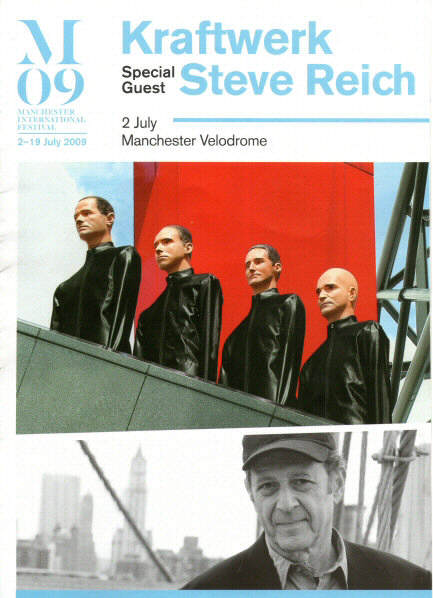
The front cover of the programme.
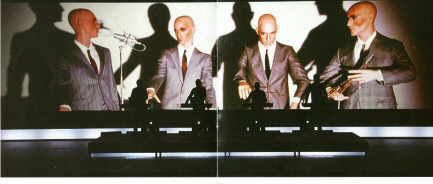
The centre-spread photograph from the programme. Even by their standards, this is scary stuff!
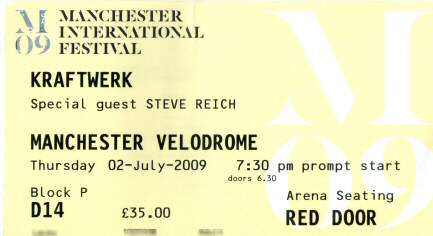
Proof!
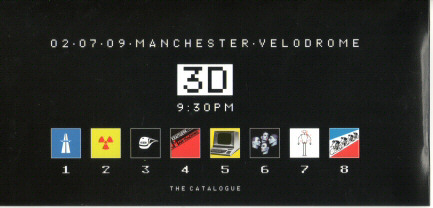
The front of the pouch for the 3D glasses.
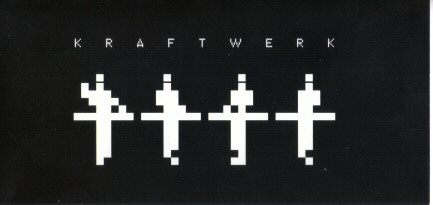
The back of the pouch.
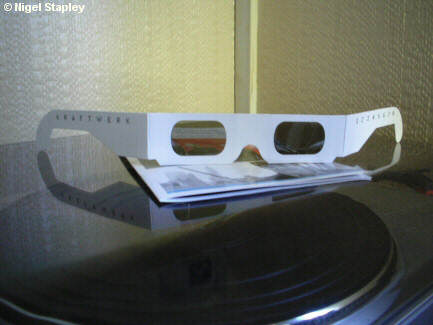
And the specs themselves.






 The Judge
RAVES!
The Judge
RAVES!











